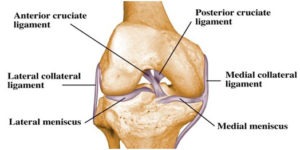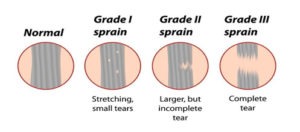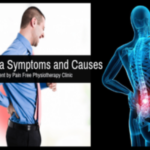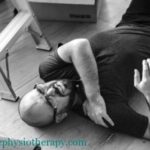What is a Ligament?
A ligament is a short tough connective tissue band composed mainly of long, wiry collagen fibers. Ligaments connect bones to other bones in and around the joints. Ligaments provide static stability to joints, which means, ligaments prevent excessive movement of joints and prevent certain movements altogether.

Figure showing Knee Ligaments
Causes of Knee Ligament Injury
Knee Ligament Injuries can occur due to sudden change in direction, wrong landing, or a blunt force hit to the knee, such as in football tackle. Muscular weakness or incoordination predisposes to a ligament sprain or tear.
Major Knee Ligaments
- ACL: Anterior Cruciate Ligament
- PCL: Posterior Cruciate Ligament
- MCL: Medial Collateral Ligament
- LCL: Lateral Collateral Ligament
- Coronary Ligament
The Grades of Knee Ligament Injuries:
The severity of symptoms of Knee Ligament Injuries depends on the degree of sprain.

- In a Grade | Sprain, the ligament is mainly stretched with a minimal tear. There is a little pain, mild swelling, and slight discomfort in weight-bearing activities.
- In a grade II sprain, there is a moderate tear (50-70% fibers torn). Moderate pain in weight-bearing activities, Swelling, and bruising can be seen around the joint. The feeling of instability may or may not be the complaint of the patient.
- In grade III sprain, there is a complete tear of the ligament. Swelling and under skin bleed can be seen at times. As a result, the joint is unstable and unable to bear weight. Often there is no pain following a grade 3 tear as all of the pain fibers are torn at the time of injury.
Treatment of Knee Ligament Injuries
Treatment of a ligament injury varies depending on its location and severity.
- A Grade I sprain may heal by itself in a few week’s time. It may take 6-8 weeks to develop maximum strength in the ligaments (time for collagen fibers to mature). Initial treatment as always in sports injury will be relative rest, icing, compression/ supporting the joint, protection (avoid painful weight-bearing activities). Some NSAIDs can be prescribed by a physician to reduce pain.
Physiotherapy is recommended to increase the healing process. This comprises electrical modalities, soft tissue techniques, strengthening exercises to guide the direction that the ligament fibers heal. This helps to prevent a future tear.
- With a grade II sprain, weight-bearing braces/ supportive taping is a must in early treatment days to relieve pain and avoid stretching of the healing ligament. After a grade II injury, usually returning to activity is possible only once the joint is stable and there is no longer pain. This usually takes six weeks.
Physiotherapy is recommended to hasten the healing process. A physiotherapist uses some modalities, soft tissue techniques, strengthening exercises, and later on, focus on complete rehabilitation so to avoid any factor that may contribute to reoccurrence.
- With a grade III injury, the patient usually wears a hinged knee brace to protect the injury from weight-bearing stresses. The aim is to allow ligament healing and gradually return to normal activities. It may take 3-4 months to completely return to sporting activity. This is again only possible with intensive Post-operative Physiotherapy rehabilitation.





